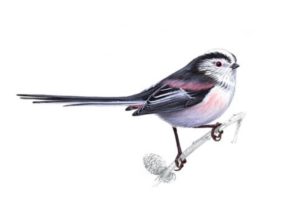 It was Clive Bennett who got me traveling down this particular track. He’s a real birder and maintains a wonderful blog – Art in Nature – where he writes of his adventures in the hedgerows and fields and where he celebrates birds and the artists who paint them.
It was Clive Bennett who got me traveling down this particular track. He’s a real birder and maintains a wonderful blog – Art in Nature – where he writes of his adventures in the hedgerows and fields and where he celebrates birds and the artists who paint them.
In a comment on a post about kennings he listed some wonderful dialect and obscure bird names then quoted from a poem by John Clare about the bumbarrel – the long-tailed titmouse or bushtit.
I love the lost and obscure names of things so I went investigating.
Here’s the poem that Clive referenced and where Clare captures the fidgety acrobatics of a drove of these very social birds – bumbarrels – flitting down the winter hedgerow. Thank you for bringing this poem and these bird words to my attention.
There are other unfamiliar words in the poem. Don’t let them get in the way of enjoyment.
Emmonsail’s Heath In Winter
I love to see the old heath’s withered brake
Mingle its crimpled leaves with furze and ling,
While the old heron from the lonely lake
Starts slow and flaps its melancholy wing,
An oddling crow in idle motion swing
On the half-rotten ash-tree’s topmost twig,
Beside whose trunk the gypsy makes his bed.
Up flies the bouncing woodcock from the brig
Where a black quagmire quakes beneath the tread;
The fieldfares chatter in the whistling thorn
And for the haw round fields and closen rove,
And coy bumbarrels, twenty in a drove,
Flit down the hedgerows in the frozen plain
And hang on little twigs and start again.
The name bumbarrel comes from the barrel or oval domed shape of their exquisitely constructed nests.
In another poem – “May” – Clare describes how this small bird – “scarse bigger than a bumble bee” builds a pudding shaped nest like a barrel:
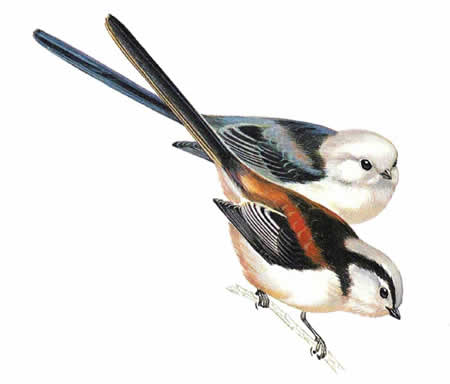 Bum-barrels twit on bush and tree
Bum-barrels twit on bush and tree
Scarse bigger then a bumble bee
And in a white thorn’s leafy rest
It builds its curious pudding-nest
Wi hole beside as if a mouse
Had built the little barrel house.
And again in this poem where he adds yet more detail;
Bumbarrel’s Nest
The oddling bush, close sheltered hedge new-plashed,
Of which spring’s early liking makes a guest
First with a shade of green though winter-dashed –
There, full as soon, bumbarrels make a nest
Of mosses grey with cobwebs closely tied
And warm and rich as feather-bed within,
With little hole on its contrary side
That pathway peepers may no knowledge win
Of what her little oval nest contains –
Ten eggs and often twelve, with dusts of red
Soft frittered – and full soon the little lanes
Screen the young crowd and hear the twitt’ring song
Of the old birds who call them to be fed
While down the hedge they hang and hide along.
John Clare
From Birds Britannica by Mark Cocker and Richard Mabey and other sources I’ve collected a list of as many vernacular names that I could find. They come tumbling off the tongue like a conversational dip into a long lost rural past.
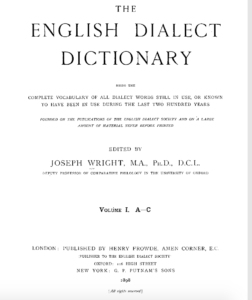 Bumbarrel, Hedge Mumruffin, Poke Pudding, Huggen-Muffin, Juffit, Fuffit, Jack-in-a-Bottle, Bottle Tom, Bum Towel, Prinpriddle, Feather Poke, Long-tailed Mag, Long-tailed Farmer, Can Bottle, Hedge Jug, Bottle Bird, Barrel Tom, Patiney, Patteny Paley, Ragamuffin, Bellringer, Nimble Tailor, French Pie, Bottle-tit, Billy-featherpoke, Long-tailed Chittering, Puddneypoke, Bottle Builder, Dog Tail, Long Pod, Bush Oven, Oven Bird and Millithrum (Miller’s Thumb) – all names for a common English bird of hedgerow and heath – the long-tailed tit.
Bumbarrel, Hedge Mumruffin, Poke Pudding, Huggen-Muffin, Juffit, Fuffit, Jack-in-a-Bottle, Bottle Tom, Bum Towel, Prinpriddle, Feather Poke, Long-tailed Mag, Long-tailed Farmer, Can Bottle, Hedge Jug, Bottle Bird, Barrel Tom, Patiney, Patteny Paley, Ragamuffin, Bellringer, Nimble Tailor, French Pie, Bottle-tit, Billy-featherpoke, Long-tailed Chittering, Puddneypoke, Bottle Builder, Dog Tail, Long Pod, Bush Oven, Oven Bird and Millithrum (Miller’s Thumb) – all names for a common English bird of hedgerow and heath – the long-tailed tit.
And a recent addition – Flying lollipop.
Each English and Scottish lowland county seems to have its own dialect word for this bird and in some cases several.
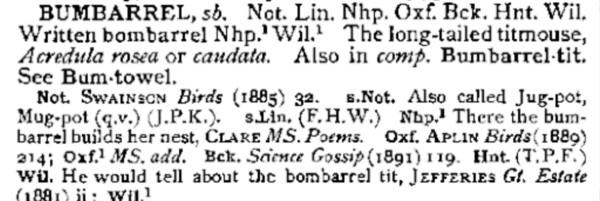
According to naturalist John Lewis-Stempel:
Bird names have become standardized, homogenized, conscripted into what is considered proper by scientists for classification. A century ago a birder could have told what county, even what village, he was in by the folk name for a long-tailed tit. In his Treatise on the Birds of Gloucestershire, W. L. Mellersh collected no fewer than 10 local names for Aegithalos caudatus, the long-tailed tit, among them long Tom, oven-bird, poke-pudding, creak-mouse, barrel Tom, and in the south of the county, long farmer. – Meadowland: the Private Life of an English Field, 2014)
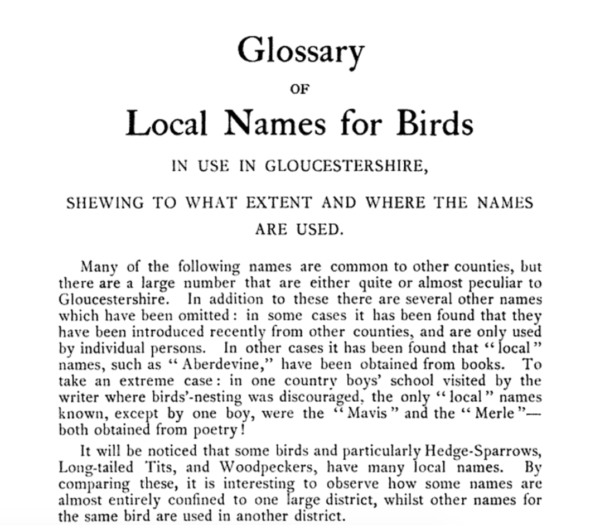
Some of the names derive from the plumage and others from the shape and design of the nests.
And here’s the key information via the RSPB:
The long-tailed tit is easily recognisable with its distinctive colouring, a tail which is bigger than its body, and undulating flight. Gregarious and noisy residents, long-tailed tits are most usually noticed in small, excitable flocks of about 20 birds.
Like most tits, they rove the woods and hedgerows, but are also seen on heaths and commons with suitable bushes.
What they eat:
Insects, occasionally seeds in autumn and winter. – Royal Society for the Protection of Birds.
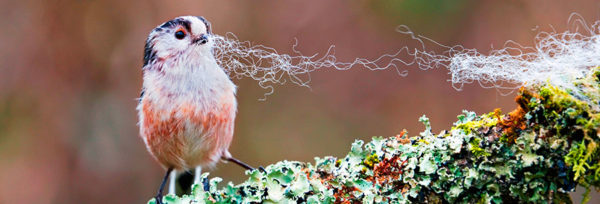
Some of these names arise from stem from the oval, domed shape of the nest. Birds Britannica tells us that each nest “comprises an intricate mix of wool and moss bound and felted together with spider’s web, camouflaged with as many as 4000 lichen flakes.” That’s a lot of building work.
Apparently long-tailed tit nests were prized decorative objects in the Victorian drawing room.
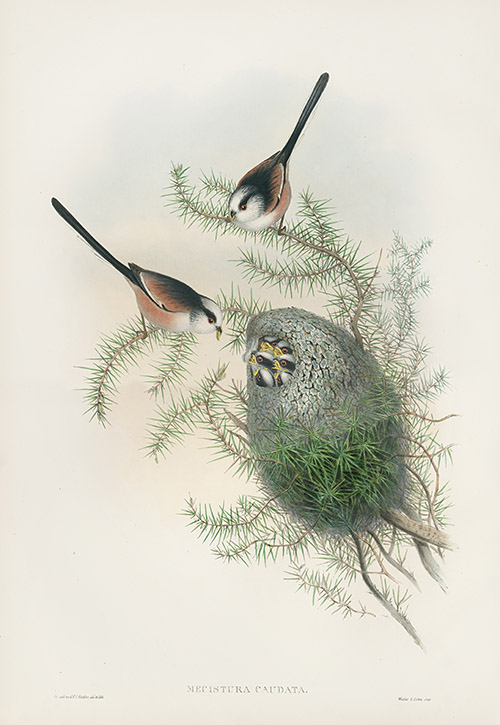
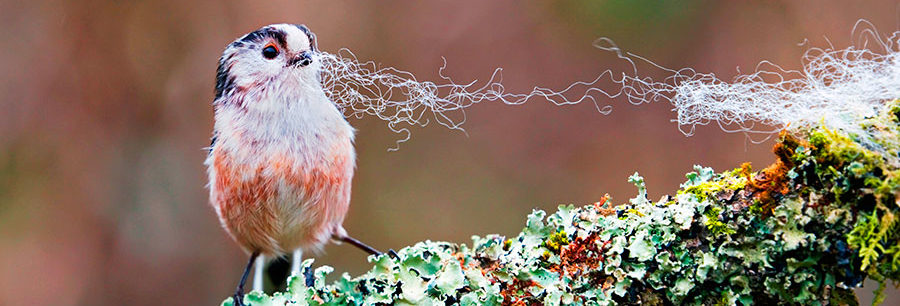


Permission granted! And thanks for that lovely description of Clare and for all the additional details about these excitable feathered fuss-budgeting acrobats. I was also reading about how – in order to enter the nest to feed their young – they have to fold that tail up over their heads.
What a lovely post about one of my favourite birds. A huge heartfelt ‘thank you’ too, for the ‘mention’ – it all helps to spread the word. With your permission I would like to reblog this on my own blog!
John Clare (1793-1864) was a keen natural historian who knew the countryside in all its moods. But what amazes, and inspires me, is without binoculars and with nothing but his senses to rely on, he gave us some of the most compelling nature writing of the 19th century.
“Clare’s greatest achievement is the conjunction of scientific accuracy with what he calls ‘poetic feeling’. He possesses a depth of knowledge only achievable by painstaking observation of birds’ behaviour as it changes with the seasons” says Dr Sarah Houghton-Walker from the Centre for John Clare Studies, at last years symposium on ‘Clare and the Art of Bird Watching’
Winter is the time that Long-tailed Tits are at their most obvious. They form loose flocks, ranging from five to 30 birds (even up to 50!) – a volery of Bumbarrels – that rove the hedgerows, now seasonally decorated with gossamer-like Old Mans Beard, or Travellers Joy, looking for feeding opportunities. Sometimes these flocks intermingle with other small birds, while at other times they are purely Long-tails!
Being in the middle of one of these feeding parties is always a delight. Their soft, bubbly contact calls fill the air as you are surrounded by these great little birds, hanging off the branches above your head or flitting past your face as they move from tree to tree, seemingly oblivious to your presence. True Faeries of the hedgerow.
I shall count the numbers flitting over my bird feeder but usually about seven or eight with three more perched in lookout posts nearby.
Sounds normal for Norfolk where, apparently, the bumbarrel was commonly known as the bush oven or oven bird. I look forward to the full nature and bird study report.
‘Bum-barrels twit on bush and tree’ shall be my poetic line of the month. Don’t you love John Clare? You have inspired me to go back to reading more of him.
It is a most delicious line. And Clare captures that Bumbarrel fidgety fuss-budgeting perfectly. Such interesting birds. And yes, John Clare is such an extraordinary observer of his world.